Land Management Effects on Microbiome
Diversity in Disease Vectors
|
Solny Adalsteinsson, Washington University (Tyson Research Center) Adrianus Boon, Washington University (School of Medicine) David Wang, Washington University (School of Medicine) Kim Medley, Washington University (Tyson Research Center) Jonathan Myers, Washington University (Biology) |
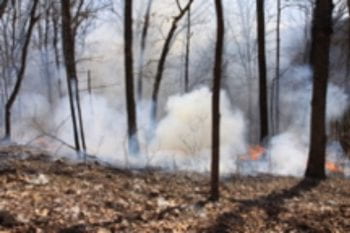
Microbes comprise the majority of Earth’s biodiversity, but only a tiny fraction have been described or understood ecologically. Within host individuals, microbiota have significant impacts on host physiology and ecology, with implications for ecosystem function and conservation of biodiversity at multiple taxonomic levels. As obligate blood-feeding parasites, ticks are important vectors of multiple disease-causing microbes, and there is increasing evidence for the role of specific microbes in determining tick survival and ability to transmit disease. How the complete microbiome affects ticks’ acquisition, survival, and transmission of pathogens remains poorly understood. Moreover, little is known about the extent of host-associated microbial diversity and the environmental factors that determine microbiome composition. In particular, fire is a natural process in many ecosystems, and prescribed fire is increasingly being used as a land management tool. Fire can affect diversity within and among communities, likely including microbiomes. Here, we will characterize the microbiomes of local ticks and test how land prescribed fire affects the structure of tick microbiomes. Results from this project will contribute to ecological theory on disturbance and biodiversity relationships and lay the foundation for future research with applications for both ecological restoration and human health.
![]()
A Carbon Garden: A Saint Louis-Based Model for
Urban Bioenergetics Carbon Capture and Storage
|
Rod Barnett, Jacqueline Margetts, Doug Ladd, Washington University (Sam Fox School of Design and Visual Arts) James Aronson, Missouri Botanical Garden |
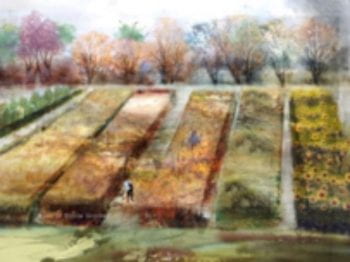 The Carbon Garden is a proposal for a new type of public space, one which achieves social objectives for public health, and scientific objectives for the study of negative carbon emissions technologies. This study intends to contribute to the development of bio-energetic carbon capture and storage (BECCS), by converting fallow urban landscapes into carbon accumulators. The project develops a design for a biodiverse carbon capture landscape within a neighborhood in North St Louis. The design investigates the biophysical and social requirements for conducting science experiments in public space. The utilization of biodiverse algae, afforestation, and grassland plant communities for BECCS is suitable for urban conditions. Previous research shows that biodiverse urban plantings are technically feasible, low cost, compatible with social objectives and, as green infrastructure, can contribute significantly to water management. This project aims to combine these results with carbon capture objectives. St Louis has approximately 25,000 acres of privately and publicly-owned vacant lots, and 108 urban parks managed by the City of St. Louis. The possibilities for reformulating under-utilized landscapes into massive carbon capture terrains is enormous. The current project stages a science/design field experiment in a location that incorporates both public and private urban terrain. It proposes that critical ecological science experiments are undertaken in public space, where citizens and scientists can interact in attractive, functional field labs that generate real data, and provide place-based neighborhood amenities.
The Carbon Garden is a proposal for a new type of public space, one which achieves social objectives for public health, and scientific objectives for the study of negative carbon emissions technologies. This study intends to contribute to the development of bio-energetic carbon capture and storage (BECCS), by converting fallow urban landscapes into carbon accumulators. The project develops a design for a biodiverse carbon capture landscape within a neighborhood in North St Louis. The design investigates the biophysical and social requirements for conducting science experiments in public space. The utilization of biodiverse algae, afforestation, and grassland plant communities for BECCS is suitable for urban conditions. Previous research shows that biodiverse urban plantings are technically feasible, low cost, compatible with social objectives and, as green infrastructure, can contribute significantly to water management. This project aims to combine these results with carbon capture objectives. St Louis has approximately 25,000 acres of privately and publicly-owned vacant lots, and 108 urban parks managed by the City of St. Louis. The possibilities for reformulating under-utilized landscapes into massive carbon capture terrains is enormous. The current project stages a science/design field experiment in a location that incorporates both public and private urban terrain. It proposes that critical ecological science experiments are undertaken in public space, where citizens and scientists can interact in attractive, functional field labs that generate real data, and provide place-based neighborhood amenities.
![]()
Floral Scent Differentiation as a
Mechanism for Pollinator Partitioning
in the Genus Anthurium (Araceae)
|
Monica M. Carlsen, Missouri Botanical Garden Nathan Muchhala, University of Missouri – Saint Louis (Biology) Gerardo Camilo, Saint Louis University (Biology) Edward Spevak, Saint Louis Zoo |
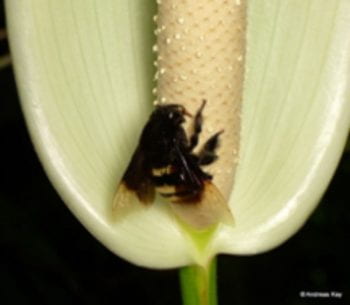 Floral scents are considered critical for the attraction and consistency of insect pollinators. In Neotropical forests, where multiple species of the same genus co-occur, and therefore compete for pollinator services, floral scents that are readily distinguished from the scent of competing species can encourage individual pollinators to exclusively visit conspecific flowers in succession. This project will compare the floral visitor and pollinator ensemble of several Anthurium species (Araceae family) co-occurring in a tropical forest community in Colombia, as well as identify the volatile compounds released by Anthurium flowers. We aim to understand how pollinator preferences, in particular floral scent preferences by bee pollinators, could potentially influence patterns of Anthurium species diversification, explain how different Anthurium species are associated with particular species of pollinators through their floral scents, and understand how many times these interactions have changed over evolutionary history using a phylogeny reconstructed with next generation sequencing data. The living Anthurium collections housed in the research greenhouses at the Missouri Botanical Garden will be used to greatly expand our sample size beyond the species encountered in the field.
Floral scents are considered critical for the attraction and consistency of insect pollinators. In Neotropical forests, where multiple species of the same genus co-occur, and therefore compete for pollinator services, floral scents that are readily distinguished from the scent of competing species can encourage individual pollinators to exclusively visit conspecific flowers in succession. This project will compare the floral visitor and pollinator ensemble of several Anthurium species (Araceae family) co-occurring in a tropical forest community in Colombia, as well as identify the volatile compounds released by Anthurium flowers. We aim to understand how pollinator preferences, in particular floral scent preferences by bee pollinators, could potentially influence patterns of Anthurium species diversification, explain how different Anthurium species are associated with particular species of pollinators through their floral scents, and understand how many times these interactions have changed over evolutionary history using a phylogeny reconstructed with next generation sequencing data. The living Anthurium collections housed in the research greenhouses at the Missouri Botanical Garden will be used to greatly expand our sample size beyond the species encountered in the field.
![]()
Assessing Fertility for Captive Asian Forest
Tortoises (Manouria emys) Using Fecal Hormone
Immunoassays and Detection of PVM Bound Sperm
|
Helen Clawitter, Saint Louis Zoo Corinne Kozlowski, Saint Louis Zoo Patricia Parker, University of Missouri – Saint Louis (Biology) and Saint Louis Zoo Laurine Augustine, Saint Louis Zoo |
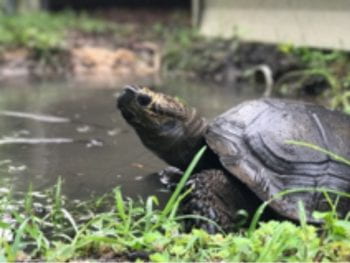 Globally, turtle species are threatened with extinction. With habitat destruction and overharvesting of turtles being the primary threat in the wild, researchers and animal conservation groups have brought many turtle species into captivity to mitigate the loss of individuals. Breeding the members of captive populations creates an assurance group; however, little is known about the reproductive physiology of many turtle species. This study will measure reproductive hormones in fecal samples to determine the normal hormone patterns for this species, as well as isolate sperm cells trapped within the perivitelline membrane surrounding the egg yolk. With the results of this project, we will have a better understanding of the Asian forest tortoise’s reproductive physiology and will be able to identify reproductively capable turtles suitable for pairing for breeding purposes.
Globally, turtle species are threatened with extinction. With habitat destruction and overharvesting of turtles being the primary threat in the wild, researchers and animal conservation groups have brought many turtle species into captivity to mitigate the loss of individuals. Breeding the members of captive populations creates an assurance group; however, little is known about the reproductive physiology of many turtle species. This study will measure reproductive hormones in fecal samples to determine the normal hormone patterns for this species, as well as isolate sperm cells trapped within the perivitelline membrane surrounding the egg yolk. With the results of this project, we will have a better understanding of the Asian forest tortoise’s reproductive physiology and will be able to identify reproductively capable turtles suitable for pairing for breeding purposes.
![]()
Evaluating Planned Grazing as an Approach
to Improving Rangeland Habitat for
Grevy’s Zebra and Pastoralists in Kenya
|
Martha Fischer, Saint Louis Zoo Belinda Low Mackey, Peter Lalampaa, Sheila Funnell, Grevy’s Zebra Trust Carolyn Lesorogol, Washington University (Brown School of Social Work) |
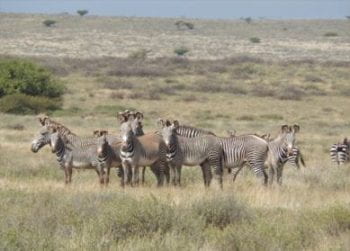 The Grevy’s zebra is an endangered species found in Kenya and Ethiopia. Only 3,000 are left in the wild with 95% found in northern Kenya where the zebras share their habitat with pastoralists. Rangeland health is critical to the future of Grevy’s zebra, other wildlife and peoples’ livelihoods in this region. However, in many areas there is increasing land degradation as a result of overgrazing by livestock, with traditionally nomadic communities becoming more sedentary and settling around growing urban centers, affecting livestock movement and grazing. Community-run conservancies have been established and may provide a mechanism to improve rangeland health through the effective management of grasslands. This project brings together a multi-disciplinary team of researchers and practitioners from Grevy’s Zebra Trust in northern Kenya and Saint Louis Zoo and Washington University in St. Louis, Missouri. The project goal is to evaluate the results of planned grazing programs carried out in Westgate Community Conservancy and compare those results to the Uaso Rongai Community in El Barta, where traditional decision-making structures and pastoralist grazing practices remain strong. Through this initiative, we aim to understand the extent to which the conservancy model has been successful in implementing measures with the potential to reverse rangeland degradation and improve grassland condition for wildlife, livestock, and people.
The Grevy’s zebra is an endangered species found in Kenya and Ethiopia. Only 3,000 are left in the wild with 95% found in northern Kenya where the zebras share their habitat with pastoralists. Rangeland health is critical to the future of Grevy’s zebra, other wildlife and peoples’ livelihoods in this region. However, in many areas there is increasing land degradation as a result of overgrazing by livestock, with traditionally nomadic communities becoming more sedentary and settling around growing urban centers, affecting livestock movement and grazing. Community-run conservancies have been established and may provide a mechanism to improve rangeland health through the effective management of grasslands. This project brings together a multi-disciplinary team of researchers and practitioners from Grevy’s Zebra Trust in northern Kenya and Saint Louis Zoo and Washington University in St. Louis, Missouri. The project goal is to evaluate the results of planned grazing programs carried out in Westgate Community Conservancy and compare those results to the Uaso Rongai Community in El Barta, where traditional decision-making structures and pastoralist grazing practices remain strong. Through this initiative, we aim to understand the extent to which the conservancy model has been successful in implementing measures with the potential to reverse rangeland degradation and improve grassland condition for wildlife, livestock, and people.
![]()
Genomic Investigation of Gut Microbiome
Associations in Freshwater Fish Assemblages
|
Fangqiong Ling, Washington University (McKelvey School of Engineering) Jason Knouft, Saint Louis University (Biology) |
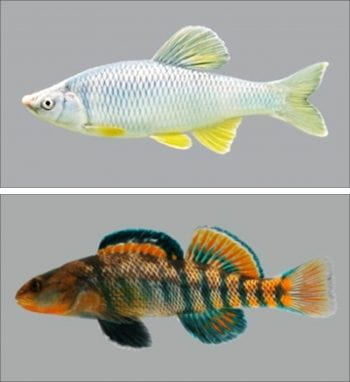 Abundant and diverse groups of microorganisms, often referred to as the microbiome, occur in and on the bodies of vertebrates and perform a variety of functions crucial to host well-being. However, whether and how the microbiome influence the host species performance, niche partitioning, or species abundance in freshwater taxa still remain open questions. This research will investigate whether the gut microbiome in freshwater fishes contributes to the regulation of patterns of abundance and species diversity in local fish assemblages in the Meramec River watershed in southeastern Missouri. Fish and river water microbiome data will be generated using metagenomics techniques from field-collected samples to investigate the relative contributions of habitat and evolutionary history to fish gut microbiome assembly. Fish gut microbiome diversity will also be related to abundance of individuals in various fish species to investigate whether microbiome characteristics in individual species are related to overall assemblage structure. The proposed work will potentially provide fundamental insights regarding the influence of microorganisms on the abundance and diversity of vertebrate host species in freshwater systems.
Abundant and diverse groups of microorganisms, often referred to as the microbiome, occur in and on the bodies of vertebrates and perform a variety of functions crucial to host well-being. However, whether and how the microbiome influence the host species performance, niche partitioning, or species abundance in freshwater taxa still remain open questions. This research will investigate whether the gut microbiome in freshwater fishes contributes to the regulation of patterns of abundance and species diversity in local fish assemblages in the Meramec River watershed in southeastern Missouri. Fish and river water microbiome data will be generated using metagenomics techniques from field-collected samples to investigate the relative contributions of habitat and evolutionary history to fish gut microbiome assembly. Fish gut microbiome diversity will also be related to abundance of individuals in various fish species to investigate whether microbiome characteristics in individual species are related to overall assemblage structure. The proposed work will potentially provide fundamental insights regarding the influence of microorganisms on the abundance and diversity of vertebrate host species in freshwater systems.
![]()
Microrefugia Against Climate Change
|
Kimberly Medley, Washington University (Tyson Research Center) Adam B. Smith, Missouri Botanical Garden Stephen Murphy, Missouri Botanical Garden Jonathan Myers, Washington University (Biology) |
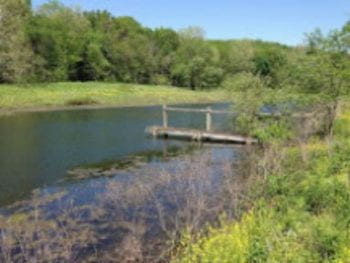 Understanding how climate change will affect the natural world requires us to be able to identify locations where species can persist despite rising temperatures. Fortunately, we have models which enable us to identify habitat that is resilient to climate change. Unfortunately, the climate data these models need are typically available at fairly coarse spatial resolutions (i.e., 0.5 miles or larger). As a result, these models cannot predict the locations of “microrefugia”, small places like sheltered coves, north-facing bluffs, or valleys that have cooler temperatures than the surrounding region. In this project we will develop a high-resolution temperature map of the Tyson Research Center of Washington University in St. Louis. The map will be paired with surveys of plant species, then used to identify landscape features that can buffer changes in the macroclimate of the surrounding region. We will then compare models using coarse climate data and the fine-scale climate data to help us understand what kinds of topographic features are important to conserve to ensure species can persist despite changing climate.
Understanding how climate change will affect the natural world requires us to be able to identify locations where species can persist despite rising temperatures. Fortunately, we have models which enable us to identify habitat that is resilient to climate change. Unfortunately, the climate data these models need are typically available at fairly coarse spatial resolutions (i.e., 0.5 miles or larger). As a result, these models cannot predict the locations of “microrefugia”, small places like sheltered coves, north-facing bluffs, or valleys that have cooler temperatures than the surrounding region. In this project we will develop a high-resolution temperature map of the Tyson Research Center of Washington University in St. Louis. The map will be paired with surveys of plant species, then used to identify landscape features that can buffer changes in the macroclimate of the surrounding region. We will then compare models using coarse climate data and the fine-scale climate data to help us understand what kinds of topographic features are important to conserve to ensure species can persist despite changing climate.
![]()
Reducing Human-Wildlife Conflict in East Africa
Using Participatory Action Research
|
Krista Milich, Washington University (Anthropology) Carolyn K. Lesorogol, Washington University (Brown School of Social Work) Sharon Deem, Saint Louis Zoo |
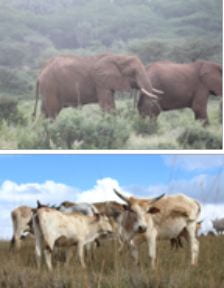 Human-wildlife conflict (HWC) is one of the greatest threats to biodiversity conservation. It threatens the survival of endangered species, results in changes to ecosystems and reduces rates of biodiversity. HWC also poses serious consequences to human health and wellness, economic security and safety. Successful attempts at human-wildlife conflict mitigation balance the conservation of endangered species with the needs of local communities. Our project addresses the problem of HWC in the East African countries of Uganda and Kenya utilizing community based participatory methods that have high potential for generating effective and sustainable solutions to HWC, thus promoting the twin goals
Human-wildlife conflict (HWC) is one of the greatest threats to biodiversity conservation. It threatens the survival of endangered species, results in changes to ecosystems and reduces rates of biodiversity. HWC also poses serious consequences to human health and wellness, economic security and safety. Successful attempts at human-wildlife conflict mitigation balance the conservation of endangered species with the needs of local communities. Our project addresses the problem of HWC in the East African countries of Uganda and Kenya utilizing community based participatory methods that have high potential for generating effective and sustainable solutions to HWC, thus promoting the twin goals 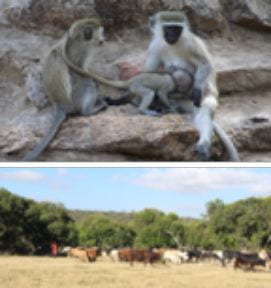 of biodiversity conservation and human well-being. Building on our long-term research in Kibale National Park in Uganda and Samburu County, Kenya, we will design participatory community engagement processes that can be scaled up to reach many communities that experience HWC. Through these processes, communities will identify the causes of HWC and develop strategies to mitigate it. Possible interventions include land use changes such as alternative crops that are unpalatable to wildlife, trenches to prevent elephants accessing farm land, bee fences to deter wildlife, strengthening fencing of livestock enclosures to prevent access by predators and other ideas generated through the participatory process. By co-designing interventions with community members and key stakeholder organizations, we intend to increase the probability that the interventions will be appropriate, feasible, and self-sustaining.
of biodiversity conservation and human well-being. Building on our long-term research in Kibale National Park in Uganda and Samburu County, Kenya, we will design participatory community engagement processes that can be scaled up to reach many communities that experience HWC. Through these processes, communities will identify the causes of HWC and develop strategies to mitigate it. Possible interventions include land use changes such as alternative crops that are unpalatable to wildlife, trenches to prevent elephants accessing farm land, bee fences to deter wildlife, strengthening fencing of livestock enclosures to prevent access by predators and other ideas generated through the participatory process. By co-designing interventions with community members and key stakeholder organizations, we intend to increase the probability that the interventions will be appropriate, feasible, and self-sustaining.
![]()